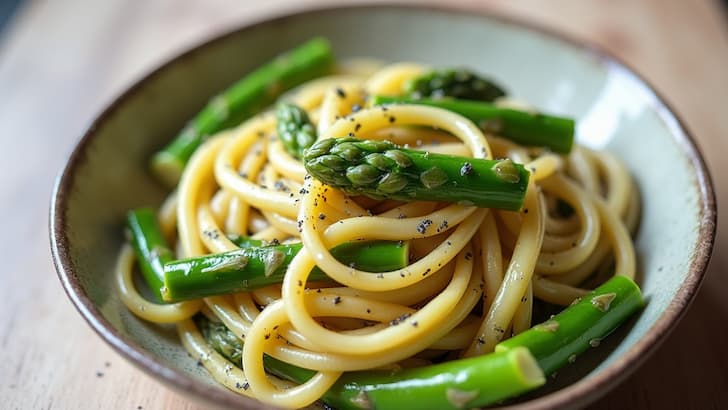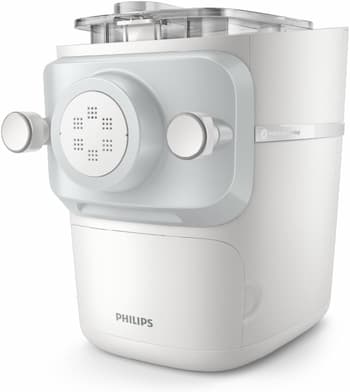The Delicious Asparagus Pasta Recipe for a Bright, Fresh Meal
This asparagus pasta recipe offers a delightful fusion of fresh flavors and simple ingredients. I have enjoyed experimenting with this dish in my kitchen, and it has become a quick favorite. The tender asparagus combined with perfectly cooked pasta creates a satisfying meal that is both light and nourishing. Every ingredient works together to deliver an excellent balance of taste and texture.
This recipe uses common items you likely already have, making it practical for a busy day when you need a flavorful dinner without a lot of fuss. The method is straightforward and the results consistently produce a dish that is both comforting and refreshing. I guarantee that this recipe will offer a pleasant change from heavier meals, especially during the warmer months.
Why You’ll Enjoy This Recipe
- No special equipment required. You only need a large pot and a frying pan.
- Fresh, vibrant flavors. The crispness of fresh asparagus and the zing of lemon complement the tender pasta beautifully.
- Quick and simple preparation. The entire dish comes together in less than 30 minutes, perfect for weeknight dinners.
- Healthy and light. This meal offers a balance of carbohydrates, vitamins, and a hint of healthy fat from olive oil.
Ingredients
Here is a list of what you will need to create this delightful asparagus pasta:
- 12 ounces of your favorite pasta (spaghetti, linguine, or fettuccine work well)
- 1 bunch fresh asparagus, trimmed and cut into 2-inch pieces
- 3 tablespoons extra virgin olive oil
- 3 cloves garlic, minced
- 1/2 cup dry white wine (optional, you can also use chicken broth)
- Juice and zest of 1 lemon
- 1/4 teaspoon red pepper flakes (adjust based on your spice tolerance)
- 1/2 cup grated Parmesan cheese
- Salt and pepper to taste
- Optional: 1/4 cup pine nuts, lightly toasted
- Optional: A handful of cherry tomatoes, halved
Step-by-Step Instructions
1. Prepare the Pasta
The first step is to bring a large pot of water to a boil. Add a generous pinch of salt once boiling, then cook the pasta according to the package instructions. Cooking the pasta until it is al dente helps it maintain a pleasant firmness that pairs well with the soft asparagus. Drain the pasta and reserve about a cup of pasta water for later use.
2. Prepare the Asparagus
While the pasta cooks, wash and trim the asparagus. I cut them into 2-inch pieces to ensure they cook quickly and evenly. In a large frying pan, heat the olive oil over medium heat. Add the asparagus pieces and sauté them for about 4 to 5 minutes. You want them to be tender yet still retaining a slight crunch, which adds texture to the dish.
3. Sauté the Garlic
Once the asparagus has softened, add the minced garlic to the pan. Stir the garlic gently so that it does not burn and becomes fragrant. This step is important because garlic brings a robust flavor that fills the entire dish, creating a pleasant aromatic base.
4. Deglaze the Pan
After the garlic has cooked for about a minute, pour in the white wine or broth. Allow the liquid to simmer for 2 minutes so that it reduces slightly. The deglazing process lifts the caramelized bits from the bottom of the pan, which are full of concentrated flavor and give a boost to the overall taste of the sauce.
5. Combine Pasta and Asparagus
Add the drained pasta into the frying pan with the asparagus mixture. Pour in a portion of the reserved pasta water to help blend the ingredients together. The pasta water contains starch that aids in creaming the sauce, giving the dish a smooth, cohesive texture. Gently toss the pasta and asparagus together, ensuring that every piece is well coated.
6. Add Lemon and Seasoning
Squeeze the juice of one lemon over the pasta and sprinkle the lemon zest into the mix. Add red pepper flakes, salt, and pepper to the dish. The lemon adds a fresh, tangy note that brightens up the flavors, while the red pepper flakes lend a subtle warmth. Stir well so that all the components are evenly distributed.
7. Final Touches
Once you are satisfied with the mixture, sprinkle the grated Parmesan cheese over the pasta. I leave a little cheese in reserve if I want to add more flavor at the table. If you choose to include pine nuts or cherry tomatoes, now is the time to fold them gently into the dish. This final step adds extra layers of texture and flavor to the meal.
Recipe Tips & Variations
- If you need to increase the dish’s creaminess, mix in a small amount of heavy cream or a dollop of ricotta cheese at the end.
- You can substitute your preferred pasta type. Penne or fusilli also work nicely with the asparagus and sauce.
- For a vegan adaptation, use a plant-based cheese alternative and skip the Parmesan. Nutritional yeast can be a good option to add a cheesy flavor.
- If you prefer a crispier texture in your asparagus, cook it for a slightly shorter duration. In doing so, the asparagus retains more of its natural snap.
- The reserved pasta water is essential when mixing the sauce. Add just enough to help the ingredients cling to the pasta without making it too watery.
- For added depth, include some halved cherry tomatoes, which provide a burst of tangy sweetness.
Frequently Asked Questions
Q: Can I use gluten-free pasta for this recipe?
A: Yes. If you are looking for a gluten-free alternative, use your favorite gluten-free pasta. Keep an eye on the cooking time as it may vary from regular pasta. The overall technique remains the same.
Q: What if I cannot find white wine?
A: White wine helps to deglaze and add a bit of acidity to the dish. If you do not have some on hand, chicken broth or vegetable broth works well as a substitute. The flavors will be slightly different, but still delicious.
Q: How should I store leftovers?
A: Leftover asparagus pasta can be kept in an airtight container in the refrigerator for up to three days. Reheat gently in a pan with a splash of water or broth to keep the pasta moist.
Q: Can I add other vegetables to this dish?
A: Absolutely. Feel free to add seasonal vegetables such as peas, spinach, or mushrooms to customize the recipe to your liking. Adjust the cooking time to ensure that added vegetables are tender yet maintain their individual textures.
Share Your Asparagus Pasta Experience!
I encourage you to prepare this asparagus pasta recipe and enjoy its refreshing flavors. Whether you are cooking a quick weeknight meal or preparing a dish to share during a relaxed dinner with family, this recipe offers flexibility and a burst of fresh taste. I appreciate hearing feedback from those who try it, so consider leaving a comment or sharing your personalized twist on the recipe. Enjoy creating and savoring every bite of this delicious meal.
This dish illustrates how simple ingredients can be transformed into a hearty yet light meal. It is ideal for days when you wish to enjoy the crisp taste of fresh vegetables without a heavy sauce weighing you down. The freshness of the lemon, the tender asparagus, and the flavorful garlic come together to create a dish that appeals to many palates.
Exploring variations may lead to new favorites. I sometimes experiment by adding a handful of baby spinach or swapping out the pasta for a more unconventional option like whole wheat fettuccine. Each change results in a unique meal that remains true to the core flavors. Understanding how each component contributes can help you adjust the dish to suit your taste perfectly.
This timely and nutritious dish is also excellent for entertaining guests. Guests often appreciate a meal that is both impressive and easy to digest. The vibrant color of the asparagus paired with the subtle hues of pasta creates a visual as well as a culinary treat. Serving this dish with a simple side salad or a piece of crusty bread makes for a complete meal that is both satisfying and elegant.
The beauty of this recipe is its adaptability. I have found that the best meals stem from creativity and a willingness to tweak the basics according to available ingredients. Every time I prepare this asparagus pasta, I stumble upon a new twist that delights my taste buds, whether it is an extra dash of lemon zest or a bit more red pepper flakes to add gentle warmth.
Additional Cooking Insights
Experimenting in the kitchen can be a creative adventure. It is very important to consider how minor tweaks can vastly change a dish's personality. For example, try including ingredients like crunchy toasted walnuts or roasted bell peppers. Mixing in these extra elements can add layers of texture that transform the meal. Think about the balance between the tangy lemon and the savory garlic as you adjust seasonings to match your taste. Being flexible with recipes not only gives you a chance to put your personal twist on a familiar dish but also teaches you more about flavor profiles. Each time you prepare your asparagus pasta, view it as an opportunity to learn more about what works best for your palate.
Another tip is to keep an eye on the cooking times for both the pasta and the vegetables. When making a dish like this, where multiple components are cooking simultaneously, it is really important to manage the heat properly. Lower the flame when simmering the sauce to ensure that the garlic does not burn and the asparagus maintains its crisp bite. Adjust the seasoning gradually, adding a splash more pasta water if the mixture feels too thick. This kind of careful attention and fine-tuning can transform a standard meal into something truly memorable.
Taking this dish to the next level doesn't just happen by following the recipe exactly. Sometimes, a little creativity and a willingness to mix things up can really boost your overall meal experience. Try serving your pasta with a side of fresh, crunchy salad or drizzling a bit extra virgin olive oil over the top, perhaps mixed with herbs for an added burst of flavor. Embracing variations not only stimulates your taste buds but also makes cooking an exciting experiment. There is always room to switch things up and stumble upon new ways to enjoy the same basic recipe over and over again.



